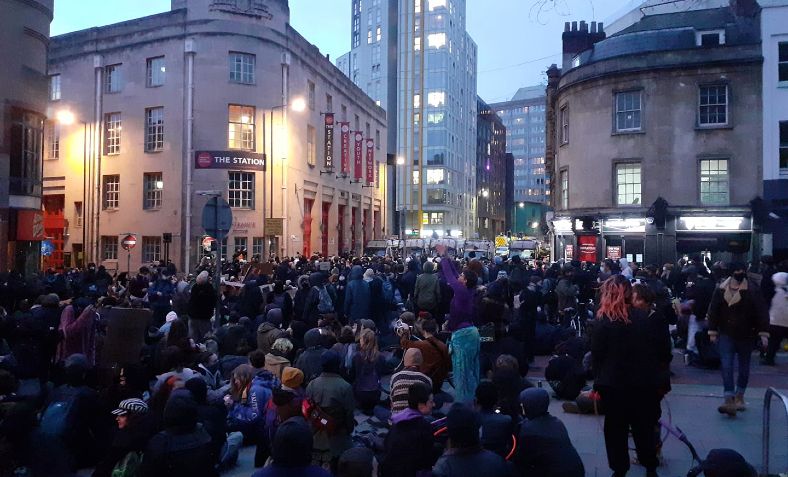 Friday 26 March 'Kill the Bill' sit-in protest outside Bridewell Police Station in central Bristol. Photo: Tom Whittaker
Friday 26 March 'Kill the Bill' sit-in protest outside Bridewell Police Station in central Bristol. Photo: Tom Whittaker
Protests in Bristol show no signs of abating and there are opportunities to deepen the movement against the Tories’ authoritarian crackdown, reports Tom Whittaker
Friday evening saw up to 3,000 people in Bristol take part in an angry and defiant protest against the Police, Crime, Sentencing and Courts Bill.
This was the third such protest in less than week and it took place in an atmosphere of palpable tension following the violent scenes outside Bridewell Police Station last Sunday and the aggressive clearing of the peace camp that had been set up on College Green on Tuesday night.
Throughout the week, Bristol’s protestors have been subject to vilification in the press and attacks from politicians, despite the fact that many of them had been the victims of police violence.
On Thursday, Avon and Somerset Police were forced to retract earlier claims they had made that police officers had suffered broken bones and that one officer had suffered a punctured lung.
Bristol has had a flourishing protest culture for much of the last decade, with most marches in the city being peaceful and often joyous affairs. However, this has now changed and Friday night saw a heavy police deployment from the off, with a considerable presence at College Green and with the narrow streets surrounding Bridewell Police station blocked by vans and lines of riot police with shields drawn and batons at the ready.
Despite this, the police were in no position to prevent people from marching, the numbers on the protest being simply too great. Around 5pm the march set off from College Green and headed through the city centre towards Castle Park, Chants of “whose streets – our streets” rang out, along with the now familiar “kill, kill, kill the bill”.
Over the next hour or so, a sit-down protest outside Bridewell police station began to develop whilst others continued to march around the city, seeking to evade police attempts to corral them. However, by around 6.30 the marchers had converged with the sit-down protestors outside the Police station and a standoff between protestors and police ensued.
With characteristic Britstol humour and in scenes reminiscent of the Vietnam war, many protestors held up spring daffodils picked from the park. Some riot police even had them placed through their lapels.
The militant nature of the protest meant that many people were reluctant to disperse and go home even as heavy rain began to fall. Nevertheless, over time and with rain still falling, numbers on the protest began to dwindle a little.
A little after 10pm, the riot police decided they had had enough and made their move. Truncheons, long shield and dogs were used to clear the lines of the protestors in violent scenes that have been well documented. A Daily Mirror journalist was assaulted despite asserting his press credentials.
However, despite the police violence the message from last night is that once again Bristol has shown that it will not be cowed and that large numbers of people can be mobilised to protest at short notice.
Nevertheless, the movement will have to confront some strategic issues going forward.
Firstly, as the stakes are upped in Bristol once again, it does make the need for solidarity from other towns and cities all the more important. The best form that solidarity can take is more protests taking place against the bill across the country. Fortunately, this is something that is starting to happen this weekend and which looks set to take place on an even wider scale on Easter Saturday.
Secondly, at some point an attempt will need to be made to draw in wider forces behind the protests and hopefully without dampening down on the radicalism of them. Last night’s protest in Bristol was overwhelmingly young people in their 20s and other layers do need to be brought in. This will require people to organise openly and to try and bring different campaign groups and trade unions on board behind the protests.
In Bristol, we should seek to get support from prominent figures on the left. We should be asking the likes of Owen Jones and Zarah Sultana to come to Bristol and march alongside us. We should also be seeking to generalise the issues and to connect, for instance, our fight for the right to protest in Bristol with the attacks by the Tories on local democracy in Liverpool.
In all this we can sadly expect little or no support from the Labour leadership under Keir Starmer, or from Bristol’s Labour mayor Marvin Rees. In 2017, Rees actually took the bold step of helping to organise a protest against austerity in Bristol.
However, on this issue he has simply backed the police line, accusing the protestors of having initiated the violence. He has also made the entirely unsubstantiated claim that many of the demonstrators are from outside of Bristol. Bristolians are rightly proud of their city’s radical nature and will fight to defend their right to express that.
Yet despite Labour’s cowardly position, British society still contains many of the radical currents of recent years and if they can be mobilised together then the Tories’ authoritarian laws can certainly be defeated.
Whether in Paris in 1968, or Bristol in 2021, it is still the case that ‘Beauty is in the street’.
Join Revolution! May Day weekender in London
The world is changing fast. From tariffs and trade wars to the continuing genocide in Gaza to Starmer’s austerity 2.0.
Revolution! on Saturday 3 – Sunday 4 May brings together leading activists and authors to discuss the key questions of the moment and chart a strategy for the left.

